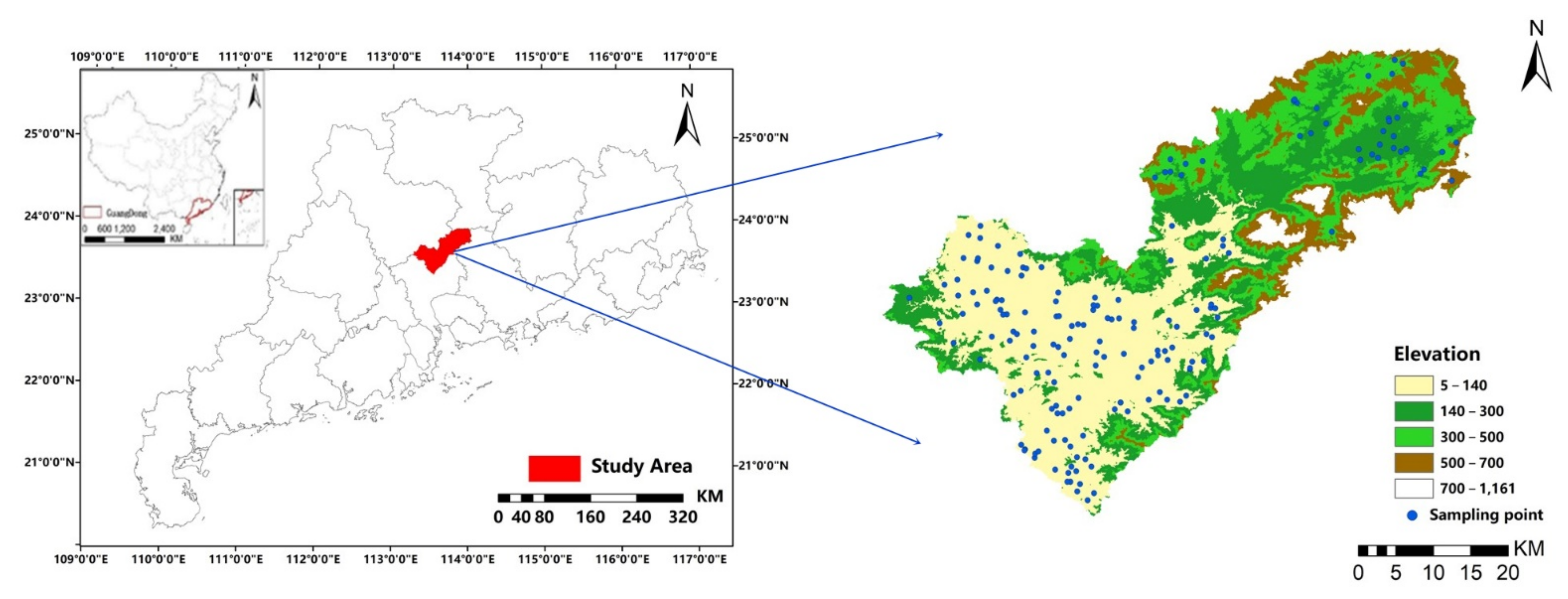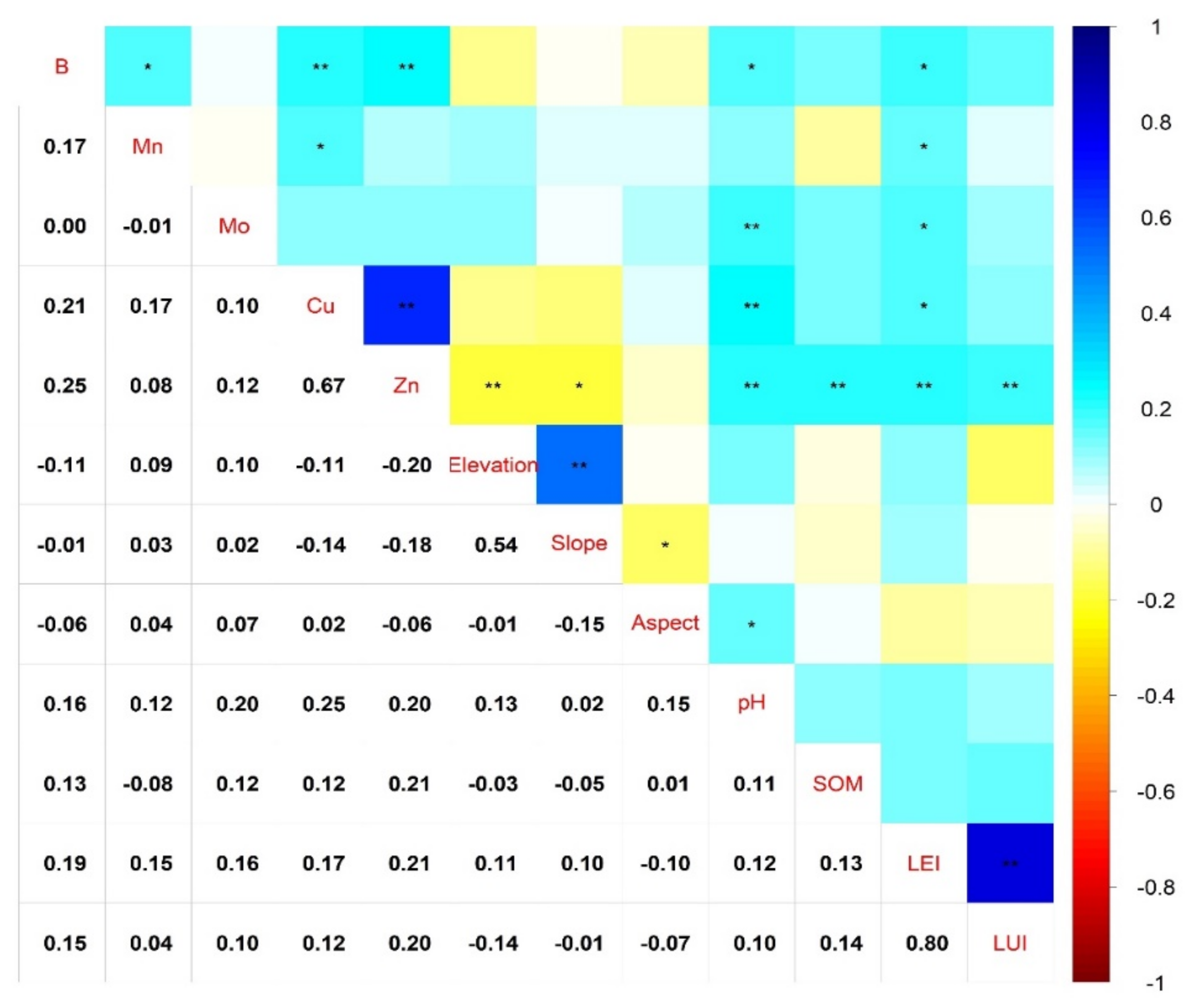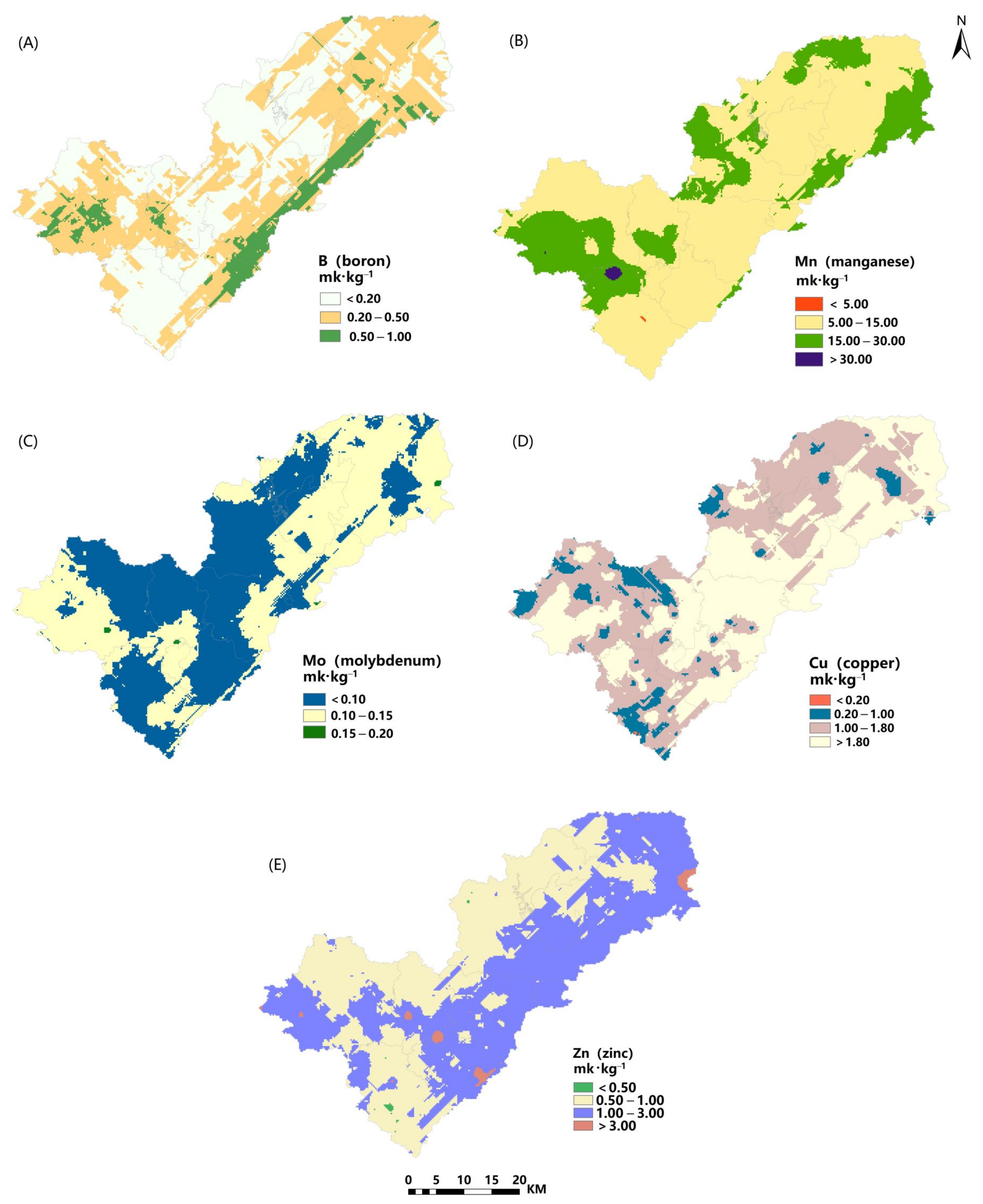Spatial Variation and Influencing Factors of Trace Elements in Farmland in a Lateritic Red Soil Region of China
Abstract
:1. Introduction
2. Materials and Methods
2.1. Study Area
2.2. Soil Sampling and Analysis
2.3. Data Processing and Analysis Methods
2.4. Accuracy Assessment
3. Results
3.1. Descriptive Statistics
3.2. Correlation Analysis of the Influencing Factors of Trace Elements
3.3. Geographically Weighted Regression Modeling and Semi Variance Function Analysis
3.4. Spatial Distribution Characteristics
3.5. Evaluation of Prediction Methods
4. Discussion
5. Conclusions
Author Contributions
Funding
Institutional Review Board Statement
Informed Consent Statement
Data Availability Statement
Acknowledgments
Conflicts of Interest
References
- Narducci, J.; Quintas, S.C.; Castro, A.; Som, C.R.; Brandt, J.S. Implications of urban growth and farmland loss for ecosystem services in the western United States. Land Use Policy 2019, 86, 1–11. [Google Scholar] [CrossRef]
- Yu, H.M.; Zhu, Q.; Fu, Q.Y.; Guo, X. Spatial variability characteristics and impacting factors of soil trace elements in Poyang Lake plain, Jiangxi of China. Plant Nutr. Fertil. Sci. 2020, 26, 172–184. [Google Scholar]
- Ballesta, R.J.; Bueno, P.C.; Rubi, J.; Giménez, R.G. Pedo-geochemical baseline content levels and soil quality reference values of trace elements in soils from the Mediterranean (Castilla La Mancha, Spain). Cent. Eur. J. Geosci. 2010, 2, 441–454. [Google Scholar] [CrossRef]
- Baldantoni, D.; Leone, A.; Iovieno, P.; Morra, L.; Zaccardelli, M.; Alfani, A. Total and available soil trace elements concentrations in two Mediterranean agricultural systems treated with municipal waste compost or conventional mineral fertilizers. Chemosphere 2010, 80, 1006–1013. [Google Scholar] [CrossRef]
- Jiang, Y.F.; Zhong, S.; Rao, L.; Sun, K.; Guo, X. Spatial variability of soil available microelement contents of cultivated land in Jiangxi Province and their influencing factors. Resour. Environ. Yangtze Basin 2018, 27, 1159–1169. [Google Scholar]
- Burgos, P.; Madejón, E.; Pérez-De-Mora, A.; Cabrera, F. Spatial variability of the chemical characteristics of a trace-element-contaminated soil before and after remediation. Geoderma 2006, 130, 157–175. [Google Scholar] [CrossRef]
- Behera, S.K.; Shukla, A.K. Spatial distribution of surface soil acidity, electrical conductivity, soil organic carbon content and exchangeable potassium, calcium and magnesium in some cropped acid soils of India. Land Degrad. Dev. 2015, 26, 71–79. [Google Scholar] [CrossRef]
- Guo, J.L.; Wu, S.W.; Jin, H.; Lu, S.G. Spatial Variability and Controlling Factors of Microelements Contents in Farmland Soils. J. Soil Water Conserv. 2010, 24, 145–149. [Google Scholar]
- Wang, G.X.; Zeng, C.; Zhang, F.; Zhang, Y.L.; Scott, C.A.; Yan, X.D. Traffic-related trace elements in soils along six highway segments on the Tibetan Plateau: Influence factors and spatial variation—ScienceDirect. Sci. Total Environ. 2017, 582, 811–821. [Google Scholar] [CrossRef]
- Bock, L.; Schvartz, C.; Colinet, G. Factors affecting trace element content in periurban market garden subsoil in Yunnan Province, China. J. Environ. Sci. 2011, 23, 488–496. [Google Scholar]
- Li, S.; Li, Q.Q.; Zhang, H.; Wang, C.Q.; Xie, Y.B.; Li, B.; Jiang, X.H. Spatial Variability of Soil Available Microelement Contents and Their Influencing Factors in Luzhou’s Tobacco Planting Area, Southwestern Sichuan. Soils 2016, 48, 1215–1222. [Google Scholar]
- White, J.G.; Welch, R.M.; Norvell, W.A. Soil Zinc Map of the USA using Geostatistics and Geographic Information Systems. Soil Sci. Soc. Am. J. 1997, 61, 185–194. [Google Scholar] [CrossRef]
- Webster, R.; Nortcliff, S. Improved estimation of micro nutrients in hectare plots of the Sonning Series. J. Soil Sci. 2010, 35, 667–672. [Google Scholar] [CrossRef]
- Li, Q.; Zhou, J.H.; Zhang, Y.A.; Wu, L.Z.; Zhang, Z.Y.; Zhang, Y.Y.; Xie, Y.; Liu, J.H. Spatial variability and influencing factors of available microelements in tobacco growing soils in Qujing. Tob. Sci. Technol. 2013, 47, 93–96. [Google Scholar]
- Yang, Q.P.; Wu, W.; Liu, H.B. Prediction of spatial distribution of soil available iron in a typical hilly farmland using terrain attributes and random forest model. Chin. J. Eco-Agric. 2018, 26, 422–431. [Google Scholar]
- Liu, F.; Rossiter, D.G.; Song, X.D.; Zhang, G.L.; Yang, R.M.; Zhao, Y.G.; Li, D.C.; Ju, B. A similarity-based method for three-dimensional prediction of soil organic matter concentration. Geoderma 2016, 263, 254–263. [Google Scholar] [CrossRef]
- Liu, F.; Zhang, G.L.; Sun, Y.J.; Zhao, Y.G.; Li, D.C. Mapping the Three-Dimensional Distribution of Soil Organic Matter across a Subtropical Hilly Landscape. Soil Sci. Soc. Am. J. 2013, 77, 1241–1253. [Google Scholar] [CrossRef]
- Koley, S. Machine learning for soil fertility and plant nutrient management using back propagation neural networks. Soc. Sci. Electron. Publ. 2014, 2, 292–297. [Google Scholar]
- Zhou, Y.; Biswas, A.; Ma, Z.Q.; Lu, Y.L.; Chen, Q.X.; Shi, Z. Revealing the scale~ specific controls of soil organic matter at large scale in Northeast and North China Plain. Geoderma 2016, 271, 71–79. [Google Scholar] [CrossRef]
- Zhao, M.S.; Liu, B.Y.; Lu, H.L.; Li, D.C.; Zhang, G.L. Spatial modeling of soil organic matter over low relief areas based on geographically weighted regression. Trans. Chin. Soc. Agric. Eng. 2019, 35, 102–110. [Google Scholar]
- Kumar, S.; Lal, R.; Liu, D. A geographically weighted regression kriging approach for mapping soil organic carbon stock. Geoderma 2012, 190, 627–634. [Google Scholar] [CrossRef]
- Griffith, D.A. Spatial~ Filtering~ Based Contributions to A Critique of Geographically Weighted Regression (GWR). Environ. Plan. A 2008, 40, 2751–2769. [Google Scholar] [CrossRef]
- Wang, Y.N.; Zhao, T. Study on Spatial Difference of Carbon Emissions in China Based on GWR Model. China Popul. Resour. Environ. 2016, 26, 27–34. [Google Scholar]
- Dai, W.J.; Wang, D.J.; Lu, Y. Evaluation of county level cultivated land quality and productivity in south China:A case study of Wuchuan City, Guangdong Province. J. Agric. Resour. Environ. 2019, 36, 419–430. [Google Scholar]
- Zeng, Z.B.; Tang, J.D.; Liu, Y.F. Changes and Driving Forces of Farmland Organic Matter in Guangdong Province, China. Soils 2013, 45, 86–92. [Google Scholar]
- Dou, L.; Du, H.Y.; Huang, Y.H.; Lai, Q.H.; You, Y.H. Main Research Achievements of Agro-geological and Eco-Geochemical Research in Pearl River Delta Economic Zone, Guangdong Province, China. Geol. Surv. China 2015, 2, 47–55. [Google Scholar]
- Ye, X.Y.; Tang, J.D. Achievements and its application prospect of cropland capacity survey and quality evaluation in Gaoming, Guangdong. Ecol. Environ. 2003, 12, 248–249. [Google Scholar]
- Shao, Y.C.; Wang, J.H.; Ge, Y. Spatial Mapping of PM2.5 Concentrationin China with Geographically Weighted Regression Kriging Model. Remote Sens. Technol. Appl. 2018, 33, 123–131. [Google Scholar]
- Zou, R.Y.; Zhou, H.J.; Guo, X.; Dan, C.L.; Lv, T.G.; Li, H.Y. Spatial Distribution and Mapping of Influencing Factors of Farmland Soil Organic Carbon in the Poyang Lake Region. Resour. Environ. Yangtze Basin 2019, 28, 121–131. [Google Scholar]
- Song, F.J.; Chang, Q.R.; Zhong, D.Y.; Fang, R.H. Spatial variability and controlling factors of soil trace elements in hilly and gully area of the Loess Plateau. Agric. Res. Arid Areas 2012, 30, 42–48. [Google Scholar]
- Wang, Z.W.; Xu, L.S.; Zhang, W.J. Corresponding Relationship between Trace Elements in Soil and Human Activity Intensity. Chin. J. Soil Sci. 2002, 33, 303–305. [Google Scholar]
- Li, J.F.; Qu, M.K.; Liu, G. Assessment of the Availability of Soil Copper and Related Influencing Factors at a County Scale. Environ. Sci. 2018, 39, 363–370. [Google Scholar]
- Wang, M.; Li, S.T.; Ma, Y.B.; Huang, S.M.; Wang, B.R.; Zhu, P. Influence of Different Long-term Fertilization Practices on Fractionations and Bioavailability of Cu, Zn, and Cd in Soils. J. Agro-Environ. Sci. 2014, 8, 1500–1510. [Google Scholar]
- Wang, R.M.; Zou, R.Y.; Liu, J.M.; Liu, L.; Hu, Y.M. Spatial Distribution of Soil Nutrients in Farmland in a Hilly Region of the Pearl River Delta in China Based on Geostatistics and the Inverse Distance Weighting Method. Agriculture 2021, 11, 50. [Google Scholar] [CrossRef]
- Li, K.; Peng, M.; Yang, Z.; Yang, K. Trace Metals Pollution and Health Risks for Planning Area Soils of 193 Chinese Cities. Environ. Sci. 2020, 41, 1825–1837. [Google Scholar]
- Zhu, J.; Huang, B.; Sun, W.X.; Ding, F.; Zou, Z.; Sun, J.P. Temporal-Spatial Variability and Its Influencing Factors of Available Trace Metals in Soils. J. Nanjing Univ. 2007, 43, 1–12. [Google Scholar]
- Mu, G.Z.; Luo, J.; Cai, L.M.; Jiang, H.H.; He, M.H.; Wang, Q.S.; Wang, S.; Wang, H.Z. Relationship between soil trace elements with Organic Matter and pH in Jiexi County, Guangdong Province. Chin. J. Agric. Resour. Reg. Plan. 2019, 40, 208–215. [Google Scholar]
- Guo, D.J.; Liu, X.H.; Xu, L.P.; Ma, Y.; Yan, S.H.; Luo, J. Effects of continuous multi season application of pig manure organic fertilizer on the contents of Cu and Zn in soil and crops in Greenhouse. Jiangsu Agric. Sci. 2020, 48, 283–286. [Google Scholar]
- Zhang, P.F.; Li, S.H.; He, Z.; Deng, Y.C.; Hu, Y.M. Collaborative mapping rice planting areas using multisource remote sensing data. In Proceedings of the 2021 IEEE International Geoscience and Remote Sensing Symposium, Brussels, Belgium, 11–16 July 2021; pp. 5969–5972. [Google Scholar]
- Zhang, J.Q.; Zheng, X.Q.; Zhang, H.L.; Lv, W.G.; Li, S.X. Effects of Long-term Straw Returning and Nitrogen Fertilizer Regulation on Soil Quality and Yields of Rice Field. Acta Agric. Boreali-Sin. 2019, 34, 185–191. [Google Scholar]
- Li, S.P.; Cai, Z.C.; Yang, H.; Wang, J.K. Effects of long-term fertilization and plastic film covering on some soil fertility and microbial properties. Acta Ecol. Sin. 2009, 29, 2489–2498. [Google Scholar]



| Elements | Max | Mini | Mean | Std. Dev. | Skewness | Kurtosis | CV/% |
|---|---|---|---|---|---|---|---|
| B (mg·kg−1) | 0.89 | 0.08 | 0.42 | 0.19 | 0.83 | −0.07 | 45.23 |
| Mn (mg·kg−1) | 46.72 | 3.20 | 13.03 | 6.23 | 2.13 | 6.85 | 47.81 |
| Mo (mg·kg−1) | 0.20 | 0.02 | 0.10 | 0.04 | 1.18 | 1.57 | 40.00 |
| Cu (mg·kg−1) | 11.42 | 0.30 | 1.65 | 0.97 | 1.73 | 4.15 | 58.79 |
| Zn (mg·kg−1) | 12.13 | 0.57 | 1.89 | 1.21 | 1.14 | 0.93 | 64.02 |
| Elements | Extremely Low | Low | Medium | High | Extremely High | Critical Value |
|---|---|---|---|---|---|---|
| B (mg·kg−1) | <0.20 | 0.20–0.50 | 0.50–1.00 | 1.00–2.00 | >2.00 | 0.50 |
| Mn (mg·kg−1) | <1.00 | 1.00–5.00 | 5.00–15.00 | 15.00–30.00 | >30.00 | 5.00 |
| Mo (mg·kg−1) | <0.10 | 0.10–0.15 | 0.15–0.20 | 0.20–0.30 | >0.30 | 0.15 |
| Cu (mg·kg−1) | <0.10 | 0.10–0.20 | 0.2–1.00 | 1.00–1.80 | >1.80 | 0.20 |
| Zn (mg·kg−1) | <0.30 | 0.30–0.50 | 0.50–1.00 | 1.00–3.00 | >3.00 | 0.50 |
| Elements | Model | Nugget (C0) | Sill (C0 + C) | NSR [Co/(C0 + C),%] | Range (Km) | R2 (%) | Residual |
|---|---|---|---|---|---|---|---|
| B | Spherical | 0.040 | 0.190 | 21.05 | 3.04 | 0.42 | 5.938 × 10−3 |
| Mn | Gaussian | 13.501 | 65.560 | 20.59 | 2.24 | 0.93 | 22.200 |
| Mo | Spherical | 0.004 | 0.013 | 30.76 | 2.76 | 0.79 | 2.356 × 10−7 |
| Cu | Exponential | 1.490 | 1.952 | 76.33 | 3.38 | 0.72 | 0.818 |
| Zn | Exponential | 1.456 | 2.143 | 67.94 | 3.23 | 0.68 | 0.654 |
| Grade | B | Mn | Mo | Cu | Zn | |||||
|---|---|---|---|---|---|---|---|---|---|---|
| Area (km2) | Proportion (%) | Area (km2) | Proportion (%) | Area (km2) | Proportion (%) | Area (km2) | Proportion (%) | Area (km2) | Proportion (%) | |
| Extremely low | 818.36 | 40.52 | - | - | 1002.56 | 50.61 | - | - | - | - |
| Low | 903.69 | 46.47 | 0.38 | 0.02 | 974.62 | 49.20 | 0.78 | 0.04 | 2.25 | 0.12 |
| Medium | 257.95 | 13.01 | 1422.06 | 71.79 | 3.43 | 0.19 | 175.13 | 8.84 | 929.62 | 46.93 |
| High | - | - | 552.44 | 27.89 | - | - | 865.00 | 43.67 | 1028.37 | 51.93 |
| Extremely high | - | - | 5.67 | 0.30 | - | - | 939.81 | 47.45 | 20.25 | 1.02 |
| Elements | Model | ME | MAE | RMSE | R2 |
|---|---|---|---|---|---|
| B | GWRK | −0.001 | 0.031 | 0.572 | 0.528 |
| Mn | GWRK | −0.040 | 5.483 | 7.667 | 0.496 |
| Mo | GWRK | 0.002 | 0.025 | 0.102 | 0.473 |
| Cu | GWRK | −0.060 | 0.781 | 1.218 | 0.686 |
| Zn | GWRK | −0.057 | 0.986 | 1.349 | 0.665 |
Publisher’s Note: MDPI stays neutral with regard to jurisdictional claims in published maps and institutional affiliations. |
© 2022 by the authors. Licensee MDPI, Basel, Switzerland. This article is an open access article distributed under the terms and conditions of the Creative Commons Attribution (CC BY) license (https://creativecommons.org/licenses/by/4.0/).
Share and Cite
Zou, R.; Zhang, Y.; Hu, Y.; Wang, L.; Xie, Y.; Liu, L.; Yang, H.; Liao, J. Spatial Variation and Influencing Factors of Trace Elements in Farmland in a Lateritic Red Soil Region of China. Agronomy 2022, 12, 478. https://doi.org/10.3390/agronomy12020478
Zou R, Zhang Y, Hu Y, Wang L, Xie Y, Liu L, Yang H, Liao J. Spatial Variation and Influencing Factors of Trace Elements in Farmland in a Lateritic Red Soil Region of China. Agronomy. 2022; 12(2):478. https://doi.org/10.3390/agronomy12020478
Chicago/Turabian StyleZou, Runyan, Yuting Zhang, Yueming Hu, Lu Wang, Yingkai Xie, Luo Liu, Hao Yang, and Jie Liao. 2022. "Spatial Variation and Influencing Factors of Trace Elements in Farmland in a Lateritic Red Soil Region of China" Agronomy 12, no. 2: 478. https://doi.org/10.3390/agronomy12020478
APA StyleZou, R., Zhang, Y., Hu, Y., Wang, L., Xie, Y., Liu, L., Yang, H., & Liao, J. (2022). Spatial Variation and Influencing Factors of Trace Elements in Farmland in a Lateritic Red Soil Region of China. Agronomy, 12(2), 478. https://doi.org/10.3390/agronomy12020478





